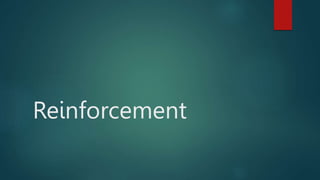
reinfocement .pptx
- 2. Reinforcement Scientific research has established a number of basic principles that explain the behavior of people and other animals. Reinforcement is one of the first basic principles that were systematically investigated by behavioral scientists, and it is a component of many applications of behavior modification. Reinforcement strengthens behavior by immediate reliable consequences, increasing the likelihood of its future occurrence.
- 3. Researches in reinforcement . Each time Thorndike put the hungry cat inside the cage it took less time for the cat to hit the lever that opened the door. Eventually, the cat hit the lever with its paw as soon as Thorndike put it in the cage (Thorndike, 1911). Thorndike called this phenomenon the law of effect. Starting in the 1930s, B. F. Skinner conducted numerous studies on the principle of reinforcement in laboratory animals such as rats and pigeons (Skinner, 1938, 1956). For example, in experiments with rats,
- 4. Outcomes Of The Researches When an animal's behavior leads to a positive outcome that contributes to its well-being or survival, the animal is more likely to repeat that behavior in similar situations. In his book Science and Human Behavior (1953a), Skinner talked about how reinforcement plays a crucial role in determining a wide range of human behaviors. According to Sulzer-Azaroff and Mayer (1991), reinforcement can occur naturally as a result of our daily interactions.
- 5. Essential in Behavior Modification A behavior that can be strengthened through reinforcement is known as an operant behavior. The consequence that strengthens an operant behavior is called a Reinforcer. Notice that the frequency of the behavior is low during baseline and higher during the reinforcement phase.
- 6. Examples from daily life Instead of paying workers by the hour, a bicycle manufacturing company begins paying piece rate, in which workers on the assembly line earn a certain amount of money for each bicycle they assemble. As a result, the workers assemble more bicycles each day and earn more money. A 2-year-old child has a tantrum (crying and screaming) in the grocery store when he demands candy and his mother says no. His mother eventually buys him the candy and he stops his tantrum. As a result, the mother is more likely to give him candy when he demands it and has a tantrum. In addition, the child is more likely to have a tantrum in the store because it results in receiving candy from his mother.
- 7. Types Of Reinforcement Positive reinforcement is defined as follows. 1. The occurrence of a behavior 2. is followed by the addition of a stimulus (a reinforcer) or an increase in the intensity of a stimulus, 3. which results in the strengthening of the behavior. Negative reinforcement, by contrast, is defined as follows. 1. The occurrence of a behavior 2. is followed by the removal of a stimulus (an aversive stimulus) or a decrease in the intensity of a stimulus, 3. which results in the strengthening of the behavior.
- 8. Social vs Automatic Reinforcement When a behavior produces a reinforcing consequence through the actions of another person, the process is social reinforcement. When the behavior produces a reinforcing consequence through direct contact with the physical environment, the process is automatic reinforcement
- 9. Condition and unconditioned Reinforcers Primary Reinforcers (Unconditioned) To meet biological needs like food water sleep etc. To avoide painful stimulation escape from danger for survival all are natural reinforcers are unconditioned Secondary Reinforcers (Conditioned) became established as a reinforcer by being paired with an unconditioned reinforcer or an already established conditioned reinforcer. For example, a parent’s attention is a conditioned reinforcer for most children because attention is paired with the delivery of food, warmth, and other reinforcers many times in the course of a young child’s life
- 10. Factors Influence Effectiveness of Reinforcement Immediacy is important in reinforcement as it should occur immediately after the desired behavior has been displayed. Contingency refers to the concept that a reinforcer should only be given if the behavior is displayed. For instance, turning the key for the ignition of a car.• Establishing operations are events that alter the value of a stimulus as a reinforcer. These events are significant in reinforcement.
- 11. SCHEDULES OF REINFORCEMENT Fixed ratio Reinforcer delivered after a certain number of responses. Produces high rate of behavior, with a pause after reinforcement Variable ratio Reinforcer delivered after an average of x responses. Produces a high and steady rate of behavior, with no pause after reinforcement. Fixed interval Reinforcer delivered for the first response that occurs after a fixed interval of time. Produces a low rate of behavior, with an on-and-off pattern. The response rate increases near the end of the interval. Variable interval Reinforcer delivered for the first response that occurs after a variable interval of time. Produces a steady, low-to-moderate rate of behavior, with no on-and-off pattern.
- 12. Thank you